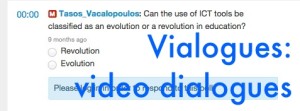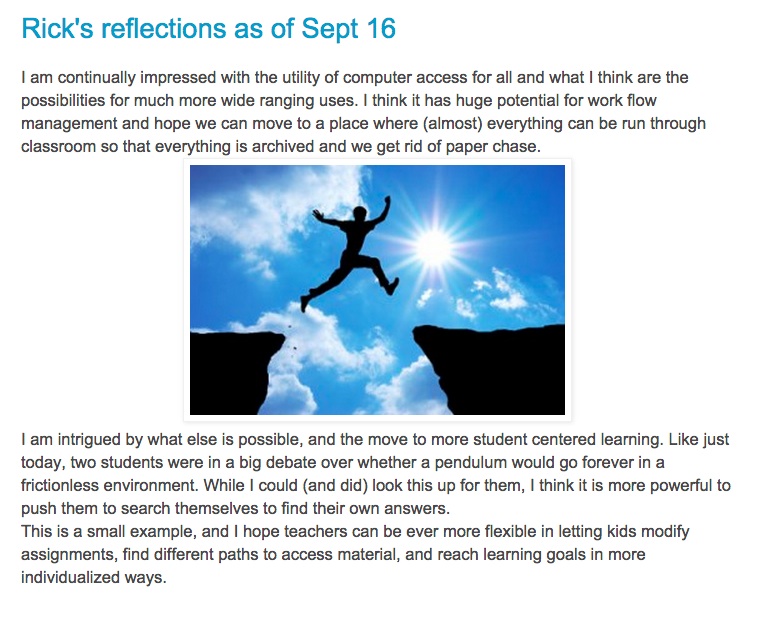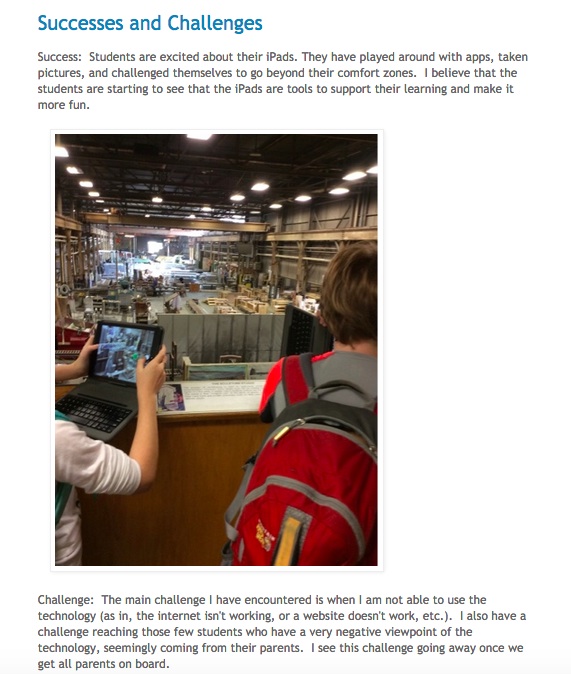Using Vialogues for social learning
 Vialogues: visual dialogues. Video dialogues.
Vialogues: visual dialogues. Video dialogues.
(Visible violet dogs? Risible eyelet hogs? Dirigible side-slit frogs?)
Vialogues are an online tool that encourages viewers to answer one specific question about a video, and the tool creates a comment thread based on the answers.
When applied in an educational capacity, this creates a space for social learning.
What is a vialogue?
As one who is interested in both how we learn and how technologies either enhance or distract from that learning process, I found this 7-minute video “Still Waiting For An Edtech Revolution” from Tasos Vacalopoulus intriguing, both for the content and the method of delivery.
The argument:
The promise of technology to revolutionize education has not come to fruition. While we know some things about how learners interact with technologies to improve the learning process, like combining words with images increases learning, the technologies themselves (i.e. Smartboards, Smartphones, tablets) don’t. Vacalopoulus emphasizes technology cannot take the place of a good teacher; rather, the role of a teacher is to inspire, motivate, and facilitate learning in a social context. “What really matters is what happens inside the learner’s head. And making a learner think seems best achieved in a social environment with other learners and a caring teacher.”
The method:
A Vialogue is a free online platform for sharing, annotating, and discussing videos from EdLab at Teachers College, Columbia University. Since learning is a social process, the interactive, social nature of a Vialogue reinforces the message. The platform creates a space for a time-stamped discussion thread. Viewers get a window into other learners’ heads via the exchange. Learn more about Vialogues with this review from Graphite and this one from TeachersFirst which includes good examples of classroom applications.
How I’m implementing it in professional development with educators
Vacalopoulus asks us to think about what experiences promote the kind of thinking that leads to learning. In our current work with our partner teachers, we have been using group blogging as a means to promote social engagement in the learning process and encourage teachers to make their thinking visible to their colleagues.

After engaging in professional development, we ask participants to reflect on their learning, to share examples of evidence that they and their students have learned, and to provide specific examples of successes and failures as they use technology to promote the kind of thinking that leads to learning.

In my experience, group blogging about professional development supports the building of a learning community by providing a social platform to make thinking visible.
How do you make use of “Vialogue-style” technology to encourage social construction of learning with your students?


Using vialogues for social learning, with @hennesss #vted https://t.co/NA2MjYXnzh https://t.co/1n1CaIVm0P
Learning as a social activity https://t.co/ttjPSOHLHV via @innovativeEd
“Learning as a social activity” with an emphasis upon networked publics. Love this concept of “vialogues!” https://t.co/8396bxogC4
#learning as a social activity. Using Vialogues for #sociallearning https://t.co/lw1AI5gbF0
RT @deiph: #learning as a social activity. Using Vialogues for #sociallearning https://t.co/lw1AI5gbF0
RT @deiph: #learning as a social activity. Using Vialogues for #sociallearning https://t.co/lw1AI5gbF0
RT @deiph: #learning as a social activity. Using Vialogues for #sociallearning https://t.co/lw1AI5gbF0
Learning as a social activity https://t.co/dYgULjWWin via @innovativeEd
Learning as a social activity https://t.co/enphtXfiMH via @innovativeEd
Learning as a social activity https://t.co/GX7ANYRNQ4 via @innovativeEd